Tourist Things to Do (and to Skip)
There are a zillion things to see in Paris. See them all. I've listed here some of my favorites, some of the classics, and some of the weirdest. You decide which is which. The thing I've listed first here is there for a reason: most people never check it out, and it really is the coolest thing in the world.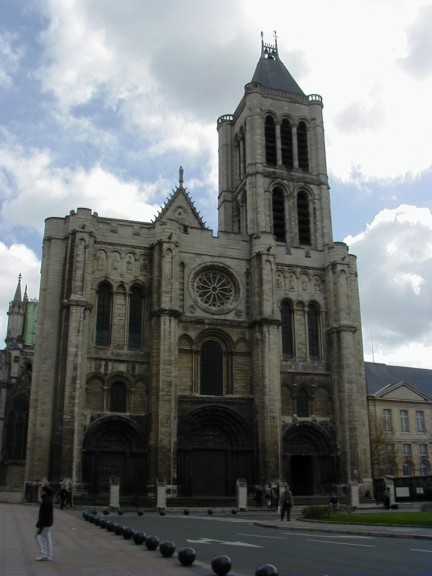
Basilica St. Denis. This is the first gothic cathedral and a real must-see. Take the metro (line 13) to the stop Basilique de St-Denis (the St. Denis–Université line, direction Saint-Denis Université, not direction Asnières—this is one of those lines that has a fork in it). You should be able to see it as you get off the metro; if you don't, just follow the signs. This is so worth it that you won't believe you never came here before. (You should know that some people find this neighborhood dodgy or sketchy. Most everyone will tell you it's perfectly fine during the day, and it's highly unlikely that you'll find yourself here after dark.) The gothic cathedral owes its existence to the Abbot Suger, who believed that "God is light," which led him in about the year 1140 to try to build towering structures that would admit large amounts of light through lots of windows. The walls couldn't support the weight and they would collapse during construction, which led to the famous flying buttresses (Tom's father was obsessed with those), which supported the weight of the roof and walls. When you visit, make sure to get the really cool headphones they have that know what you're looking at and narrate to you what you're seeing in whatever language you choose (within reason, of course). Make sure to see the crypt—really. They have all (well many) of the dead kings' tombs here (I guess it's lucky they're dead), and they have Louis XIV's heart in a reliquary (although it's kind of hard to see). This might be the single most interesting thing to see in Paris (actually it's just outside of Paris, but leave me alone, I've been writing for a long time).
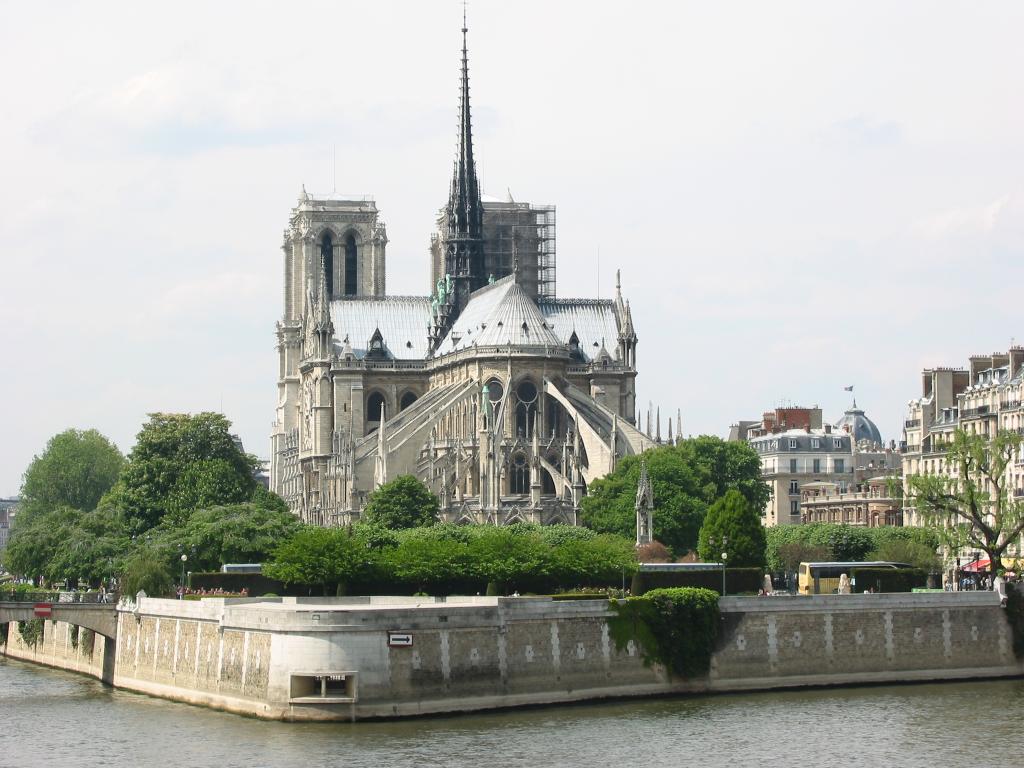 Notre Dame. Everybody knows a horrendous fire all but destroyed the cathedral on April 15, 2019. Some people do not know that the fire damage was so severe the entire ediface nearly collapsed (and Tom was enraged recently when photographing the renovations and a stupid American hipster actually flipped his ponytail as he walked by and said, "It's a building; it can be fixed.") The fact is that the flying buttresses, which allowed for the construction of such high and heavy walls with windows in them by counter-balancing their weight, nearly collapsed when the weight of the roof—most of which was destroyed, along with the cathedral's
Notre Dame. Everybody knows a horrendous fire all but destroyed the cathedral on April 15, 2019. Some people do not know that the fire damage was so severe the entire ediface nearly collapsed (and Tom was enraged recently when photographing the renovations and a stupid American hipster actually flipped his ponytail as he walked by and said, "It's a building; it can be fixed.") The fact is that the flying buttresses, which allowed for the construction of such high and heavy walls with windows in them by counter-balancing their weight, nearly collapsed when the weight of the roof—most of which was destroyed, along with the cathedral's  spire—was suddenly dramatically reduced. The bell towers almost went down, too, which would have devastated the rest of the structure (the largest bell weighs over 28,000 pounds). This "building that can be fixed" is 900 years old, and it came within hours or even minutes of crashing completely to the ground.
spire—was suddenly dramatically reduced. The bell towers almost went down, too, which would have devastated the rest of the structure (the largest bell weighs over 28,000 pounds). This "building that can be fixed" is 900 years old, and it came within hours or even minutes of crashing completely to the ground.
By now most people know that over 400 firefighters fought the blazes; and that the roof, which was mostly lead, was nearly completely destroyed, producing a significant environmental danger; and that every bit of the art and the relics the cathedral contained was saved. Many people may have heard that crazy, modern designs were going to replace the original gothic cathedral, but all of that was nonsense, played out when a replica of the spire, complete with goden rooster on top, was erected). Most of the real controversy focused on materials—would wood continue to support the cathedral's roof? And the answer is yes (as opposed to some cathedrals around Europe which, when damaged by fire, had their internal support structures shifted to steel or other modern materials). Some 2000 craftspeople from all over the world came to work on the cathedral, and the photo here shows nearly 400 of them assembled inside the completely renovated cathedral.
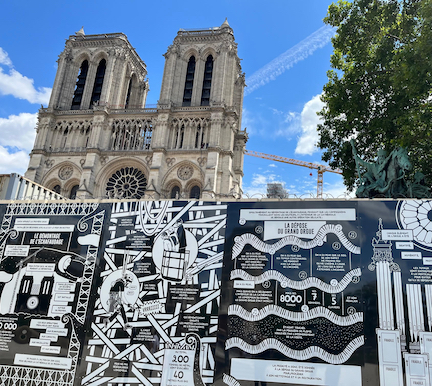 The renovation efforts are nothing short of heroic. Expert craftspeople lower themselves to their jobs on tethered ropes or bunjie cords; people have been brought in from all over to repair and restore stained glass windows, flooring, stone, you name it. While originally the cathedral was set to be reopened for the 2024 Olympics in Paris, that didn't happen.
The renovation efforts are nothing short of heroic. Expert craftspeople lower themselves to their jobs on tethered ropes or bunjie cords; people have been brought in from all over to repair and restore stained glass windows, flooring, stone, you name it. While originally the cathedral was set to be reopened for the 2024 Olympics in Paris, that didn't happen.
In these photos of the renovation you can see the bande dessinée (or comic book) art and info that 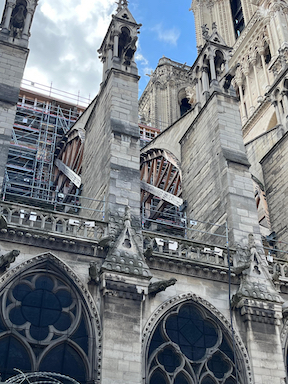 spans the front of the cathedral explaining the history and renovation of the structure.
spans the front of the cathedral explaining the history and renovation of the structure.
You can also see the wooden trusses hand-built for each of the 28 flying buttresses that help remove the downward and linear force these structures apply to counter-balance the weight of the roof (necessary since the roof is gone).
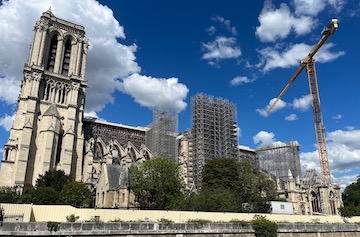 The renovation's progress is most easily seen from the side of the cathedral that faces the river. You can see that the roof is still gone (but the interior of the cathedral is protected from the elements by temporary fixes such as tarps) and the cranes and scaffolding continue to dominate the scene. Workers have come from all over to help in
The renovation's progress is most easily seen from the side of the cathedral that faces the river. You can see that the roof is still gone (but the interior of the cathedral is protected from the elements by temporary fixes such as tarps) and the cranes and scaffolding continue to dominate the scene. Workers have come from all over to help in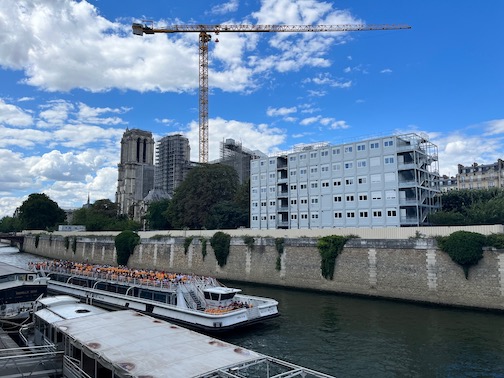 this renovation, and many of them are temporarily housed in structures such as the one you see to the right in this photo.
this renovation, and many of them are temporarily housed in structures such as the one you see to the right in this photo.
There is an absolutely brilliant virtual reality exhibit about Notre Dame that is one of the most highly immersive that Tom has ever experienced. Entitled L'Eternelle Notre Dame, this stunning exhibit can be accessed at the underground entrance at the far end of the square ("parvis") in front of the cathedral, which is across from 6, rue de la Cité (see map below). The helpful staff will strap a computer device to your back (Tom guesses it weighs about 8 pounds) and fit a headset with goggles and earphones onto your head; then they'll point you in the right direction and you'll follow your virtual guide from the very beginnings of the cathedral in the 12th century up through the fire and the reparations that are still going on. The exhibit is so highly immersive that sometimes you'll genuinely fear falling from great heights, and others you'll find yourself bending over to get through small openings (and of course there are no real physical barriers here, but I promise you'll bend down anyway). Tom highly recommends this amazing way of visiting one of the world's great cathedrals.

Less than a stone's throw away from Notre Dame (if you can throw pretty hard) from Notre Dame is the absolutely breathtaking Sainte-Chapelle. Situated on the Ile de la Cité, within the complex constituted by the Palais de la Cité and the Conciergerie, the Sainte-Chapelle is a thirteenth-century chapel that was situated within the palace on the Ile de la Cité where most of the kings of France up through the fourteenth century lived. Legend has it that the Sainte-Chapelle was constructed to house the crown of thorns (which is currently in Notre Dame). The Sainte-Chapelle is constructed in what's called the rayonnant Gothic style, which means that the lines of the architecture draw your eyes upwards. But the thing you can't miss—and likely can't get over—is the absolutely stunning stained glass. With something like fifteen windows, each more than forty feet high and over 1,000 scenes depicted, this is without a doubt the most breathtaking stained glass display you will ever see.
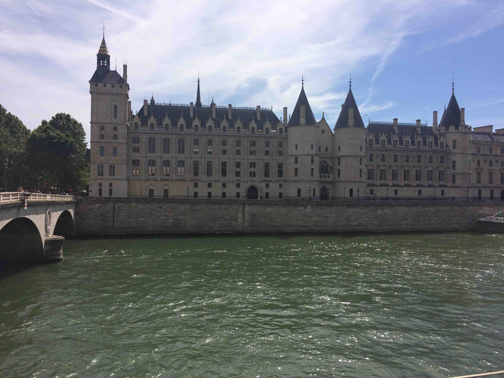 Attached to the Sainte-Chapelle is the Conciergerie, which some of you may recall was featured in the 2024 summer Olympics opening ceremony when a beheaded Marie Antoinette sang from the structure, followed by metal artist Gojira. This entire complex (see Sainte-Chapelle above) was built during medieval times to house the kings of France, which lasted until the 14th century; when Charles V moved his lodgings to the Louvre, the Conciergerie became an administrative structure and it also became a prison. During the Revolution and the Reign of Terror, the Conciergerie housed those prisoners who were about to face the guillotine, and you can visit those bleak cells. There's a really striking room that has the names of the people who were beheaded during the terror (there's something like 2,500 of them), and you can also see the cells of famous people, including Queen Marie Antoinette. They sometimes have the blade of the guillotine on display. Tom's not saying that he's touched it.
Attached to the Sainte-Chapelle is the Conciergerie, which some of you may recall was featured in the 2024 summer Olympics opening ceremony when a beheaded Marie Antoinette sang from the structure, followed by metal artist Gojira. This entire complex (see Sainte-Chapelle above) was built during medieval times to house the kings of France, which lasted until the 14th century; when Charles V moved his lodgings to the Louvre, the Conciergerie became an administrative structure and it also became a prison. During the Revolution and the Reign of Terror, the Conciergerie housed those prisoners who were about to face the guillotine, and you can visit those bleak cells. There's a really striking room that has the names of the people who were beheaded during the terror (there's something like 2,500 of them), and you can also see the cells of famous people, including Queen Marie Antoinette. They sometimes have the blade of the guillotine on display. Tom's not saying that he's touched it.
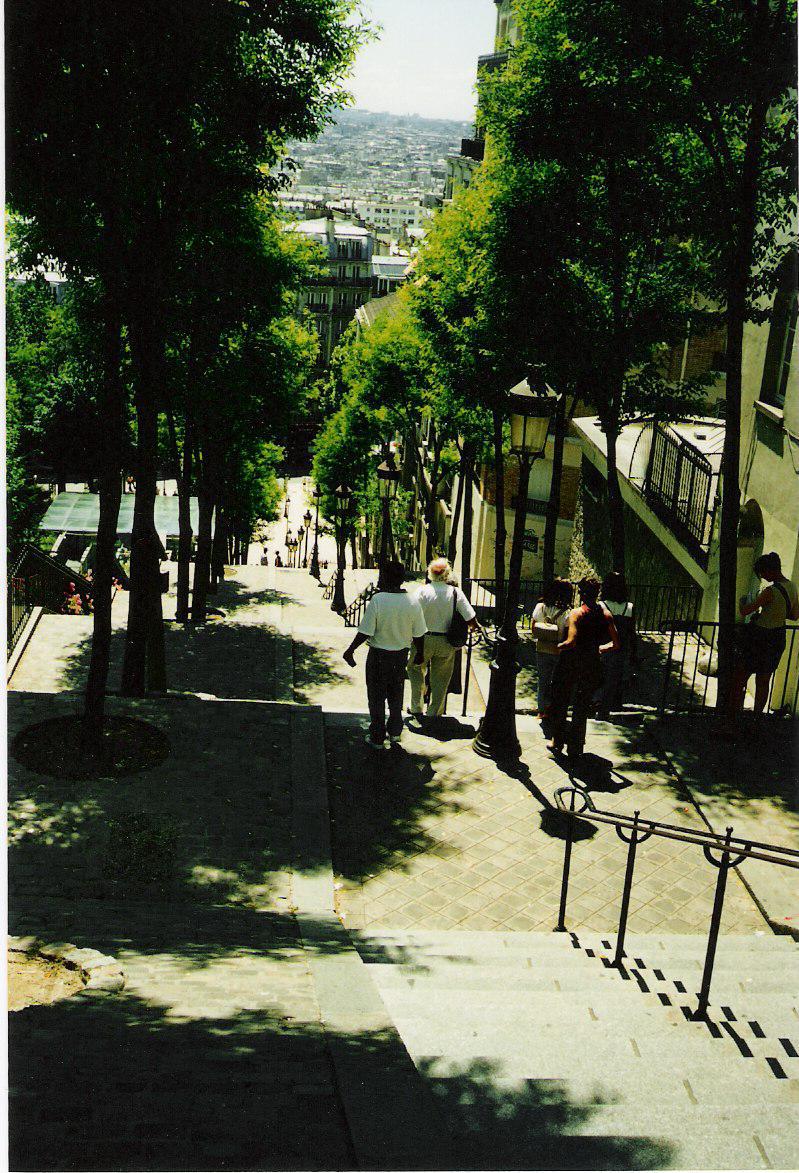 Montmartre. This is an evening/nighttime thing in Tom's opinion. The name "Montmartre" comes from the phrase mountain of the martyrs, which comes from the legend that Saint Denis, a Catholic bishop, was decapitated in the year 250 by the Romans for preaching Christianity. The bishop picked up his head and carried it to the site of the current Montmartre. Since the 12th century there have been churches in Montmartre, and begining in the 15th century it was a small village surrounded by orchards, farmland, and vinyards (and there is still a functioning vineyard on top of the hill). Beginning in the 19th century, some of the artists we now
Montmartre. This is an evening/nighttime thing in Tom's opinion. The name "Montmartre" comes from the phrase mountain of the martyrs, which comes from the legend that Saint Denis, a Catholic bishop, was decapitated in the year 250 by the Romans for preaching Christianity. The bishop picked up his head and carried it to the site of the current Montmartre. Since the 12th century there have been churches in Montmartre, and begining in the 15th century it was a small village surrounded by orchards, farmland, and vinyards (and there is still a functioning vineyard on top of the hill). Beginning in the 19th century, some of the artists we now
 recognize as the most influential of their time—Picasso, Utrillo, Renoir—had studios in the neighborhood and in a building known as the Bateau-Lavoir, which still stands (see map). Now it is a beautifully picturesque neighborhood with innovative restaurants, excellent bars and cafés, along with top-notch retail, music, and people-watching. And the views from up there ain't bad, either.
recognize as the most influential of their time—Picasso, Utrillo, Renoir—had studios in the neighborhood and in a building known as the Bateau-Lavoir, which still stands (see map). Now it is a beautifully picturesque neighborhood with innovative restaurants, excellent bars and cafés, along with top-notch retail, music, and people-watching. And the views from up there ain't bad, either.
To get to Montmartre, take the metro to Abbesses and follow the signs to Sacré Cœur, which is a 19th-century basilica that you must see. You'll have to climb a lot of hills and stuff in this neighborhood or, if you don't want to take the 220 odd steps you see above,
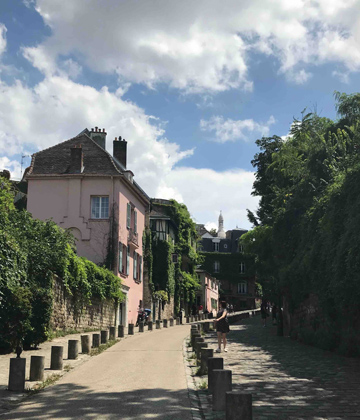 you can take the funiculaire that will take you up the same slope, and, interestingly enough, your metro tickets and/or pass navigo work there. At the top of the stairs/funiculaire, turn around and take in the extraordinary view of the city lying beneath you. Tom thinks the view is best at sunset, because the shadows put the buildings in relief and when the lights start coming on you feel like you're both inside and above the city, a feeling enhanced by the odd lack of city noise you can hear.
you can take the funiculaire that will take you up the same slope, and, interestingly enough, your metro tickets and/or pass navigo work there. At the top of the stairs/funiculaire, turn around and take in the extraordinary view of the city lying beneath you. Tom thinks the view is best at sunset, because the shadows put the buildings in relief and when the lights start coming on you feel like you're both inside and above the city, a feeling enhanced by the odd lack of city noise you can hear.
Now turn around and make your way up the steps to the 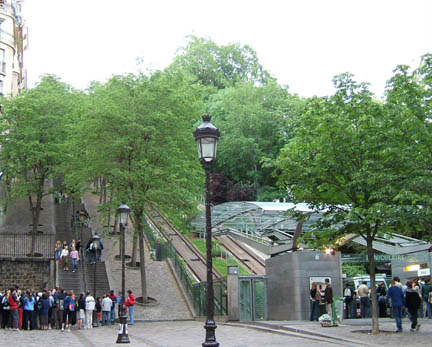 Sacré Cœur basilica, which may look old but is actually a late nineteenth-century structure. If you have done as Tom suggested and come here around sunset, the steps leading up to the basilica will be packed with mostly young people, playing music, furtively (or not) drinking beer or wine, dancing, and basically carrying on. When you get to the top of the stairs, check out the view of the city again—it's even better. Then, follow the crowd around the side of the basilica and head into the crowded streets that lead to the Place du Tertre, which used to be a place where real artists painted but is now frequented by people who will
ask you for insane amounts of money to paint an unflattering caricature of you. Resist absolutely. Thing is, for all the stuff not to like about Montmartre, it's pretty great.
Sacré Cœur basilica, which may look old but is actually a late nineteenth-century structure. If you have done as Tom suggested and come here around sunset, the steps leading up to the basilica will be packed with mostly young people, playing music, furtively (or not) drinking beer or wine, dancing, and basically carrying on. When you get to the top of the stairs, check out the view of the city again—it's even better. Then, follow the crowd around the side of the basilica and head into the crowded streets that lead to the Place du Tertre, which used to be a place where real artists painted but is now frequented by people who will
ask you for insane amounts of money to paint an unflattering caricature of you. Resist absolutely. Thing is, for all the stuff not to like about Montmartre, it's pretty great.  I'd refain from eating at any of the restaurants facing the main square, but they're not horrible, although some of the ones around back are likely much better. You'll note a certainly Disney-like feel to this place, owing in part to the lighting and also in part to the insane amount of memorabilia shops aimed at tourists. But don't just stay at the very top: wander around a bit. By all means—and this is something you should do during the day, of course—go inside the basilica (although it is open at night as well). There are some interesting diagrams on the right side as you enter about where bombs fell during the war, and the byzantine opulence of the interior is well wroth seeing. Above all, do climb to the top of the basilica's dome
I'd refain from eating at any of the restaurants facing the main square, but they're not horrible, although some of the ones around back are likely much better. You'll note a certainly Disney-like feel to this place, owing in part to the lighting and also in part to the insane amount of memorabilia shops aimed at tourists. But don't just stay at the very top: wander around a bit. By all means—and this is something you should do during the day, of course—go inside the basilica (although it is open at night as well). There are some interesting diagrams on the right side as you enter about where bombs fell during the war, and the byzantine opulence of the interior is well wroth seeing. Above all, do climb to the top of the basilica's dome 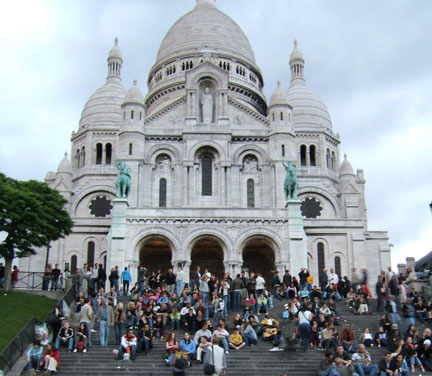 (the entrance is around to the side of the building). At the first level you'll be able to look out into the basilica's interior from quite a ways up. If you're not claustrophobic, you can climb all the way to the top of the dome, and get one of the most remarkable views imaginable of the entire city of Paris. This is not for those who dislike tight places, by the way: if someone is coming down the top-level steps while you're trying to go up, you'll, um, get to know them very well.
(the entrance is around to the side of the building). At the first level you'll be able to look out into the basilica's interior from quite a ways up. If you're not claustrophobic, you can climb all the way to the top of the dome, and get one of the most remarkable views imaginable of the entire city of Paris. This is not for those who dislike tight places, by the way: if someone is coming down the top-level steps while you're trying to go up, you'll, um, get to know them very well.
Wander around the small, winding streets during the day or evening and you'll be pleasantly surprised at every turn. Look in particular at the Rue des Trois Frères, the rue Norvins, the rue des Saules, the rue Lepic, and the rue Yvonne le Tac. Look also for the Avenue Junot, the rue Simon Dereure, and the rue Girardon. You'll find great places to eat and drink all 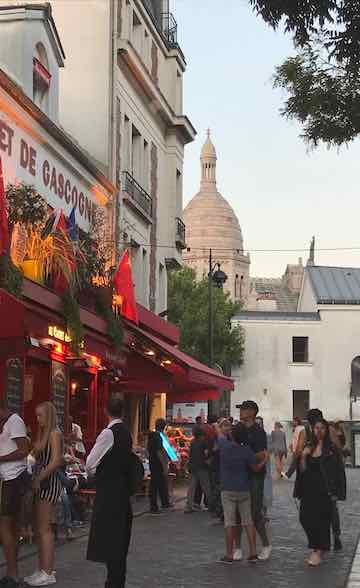 over, including more places offering vegetarian and vegan fare. If you're a fan of nineteenth- and early twentiety-century art, especially impressionism and cubism, you should definitely take a walk over to the rue Ravignan, which leads into the Place Emie Goudeau, where you'll find the Bateau-Lavoir. As mentioned earlier, this was the meeting place of many a now famous game-changing painter; musicians and theater folks also hung out here. The structure is largely refurbished because of a fire in 1970, but you'll definitely still get the vibe. By the way, you should also check out the area at Abbesses, where I told you to get out of the metro. It's got one of only two few remaining original covered metro stops. Take a walk along the rue des Abbesses heading west, to where it turns into the rue Joseph de Maistre—good eats and drinks there.
over, including more places offering vegetarian and vegan fare. If you're a fan of nineteenth- and early twentiety-century art, especially impressionism and cubism, you should definitely take a walk over to the rue Ravignan, which leads into the Place Emie Goudeau, where you'll find the Bateau-Lavoir. As mentioned earlier, this was the meeting place of many a now famous game-changing painter; musicians and theater folks also hung out here. The structure is largely refurbished because of a fire in 1970, but you'll definitely still get the vibe. By the way, you should also check out the area at Abbesses, where I told you to get out of the metro. It's got one of only two few remaining original covered metro stops. Take a walk along the rue des Abbesses heading west, to where it turns into the rue Joseph de Maistre—good eats and drinks there.
Lastly, if you want to catch some of the latest indie, hip hop, metal, rock, and all sorts of international varieties, there are two places right at the edge of Montmartre, both of which are over 100 years old. La Cigale is a sprawling space that has welcomed tons of international music all-stars (120 blvd Marguerite de Rochechouart, 18th, métro Pigalle or Anvers; 01 49 25 89 990; and literally right next door, in the same building is the far more intimate (think 200 seats) La Boule Noire. These are both extremely active and popular venues, especially for the 20-something set.
Boat ride on the Seine. Yeah, you should probably do this. It will look really hokey when you look at the boats from the shore, but once you're on the thing I'm sure you'll love it. You can do meal cruises on these things, with prices ranging from 50 euros for lunch to 135 euros for dinner, but you can also get away with just riding on the boats and enjoying the scenery for under 15 euros. You'll note there are almost a dozen companies that operate these these river cruises, too, so you'll have to either (a) do your homework or (b) just jump on the nearest one and see what happens (Tom would opt for choice b). I suggest taking one of these at sunset or at night.
Tom's Map of Tourist Things To Do
Tuileries. Metro Tuileries, Palais Royal, or Concorde. This is a garden-type thing at the west end of the Louvre. Hang out here and sit in one of the iron chairs. Watch old ladies. Look at the flowers. You should definitely go to the Tuileries, which are quite beautiful. It's good to go here after you've spent a long time in the Louvre, because you can kind of get your vision back after focusing closely on very detailed stuff for a while. Often in the summer they'll have strange festivals here with rides and such. You should absolutely go on the giant Ferris wheel if it's up when you're there (but the jury is still out on whether you should buy the truly odd picture they take of you when you're getting off the wheel). Be forewarned that the ferris wheel might seem like a bit of a ripoff, since you only get a couple revolutions. Interestingly, even people who are smart often don't know that the name 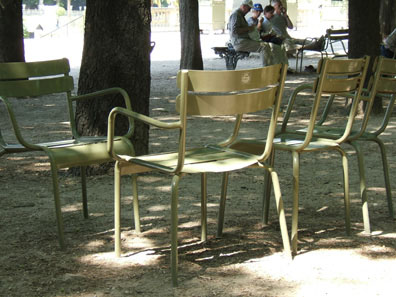 "tuileries" comes from the factories that used to be around this area that produced roof tiles (tuiles). There, now you know, and you can lord it over people.
"tuileries" comes from the factories that used to be around this area that produced roof tiles (tuiles). There, now you know, and you can lord it over people.
Now, speaking of those iron chairs, they have the same ones in the Jardins du Luxembourg, where you should, of course, also go. But I don't feel like describing that lovely spot right now; I want to talk about those damned chairs. There are two different kinds, and if you're new to this you won't notice and you will hence get screwed out of a more comfortable visit. Regulars, however, know the difference, and they train their hawk-like eyes on the ones that have armrests. It's not just about the armrests themselves—these chairs are engineered better, and there's something about the angle of the seat to the back that makes them more c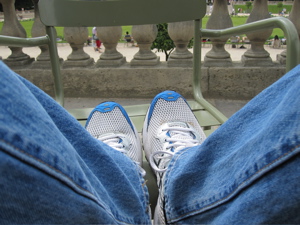 omfortable. OK, so much for the physics of this. The really interesting part is the sociology of the whole thing. Most people sitting in one of these parks that have the iron chairs will do everything they can to (1) get an armrest chair; and (2) get another, non-armrest chair to put their feet on. It's not just that they'll try to do this: watch the subtle way they go about rounding up their prized iron possessions. Since you can't legitimately deprive someone else of a place to sit just so you can rest your tired dogs, you have to be very crafty in arranging things so you get one of the good chairs to sit on and one of the cruddy ones for your feet. And people won't ever quite lunge for a good chair—they'll kind of walk nonchalantly toward one, increasing their speed if they see someone else aiming for the same chair. It's really a trip.
omfortable. OK, so much for the physics of this. The really interesting part is the sociology of the whole thing. Most people sitting in one of these parks that have the iron chairs will do everything they can to (1) get an armrest chair; and (2) get another, non-armrest chair to put their feet on. It's not just that they'll try to do this: watch the subtle way they go about rounding up their prized iron possessions. Since you can't legitimately deprive someone else of a place to sit just so you can rest your tired dogs, you have to be very crafty in arranging things so you get one of the good chairs to sit on and one of the cruddy ones for your feet. And people won't ever quite lunge for a good chair—they'll kind of walk nonchalantly toward one, increasing their speed if they see someone else aiming for the same chair. It's really a trip.
Invalides. Metro Invalides. This is paradoxically both boring and interesting. Go here if you like Napoleon. He's buried there.
 Eiffel Tower. This is on my list of things both to avoid and to do. Don't like paradox? Deal with it. First, I think you'll spend a lot of time waiting in line to go up to the top, and once you get there (if you haven't had all your money stolen by the pickpockets who congregate there like flies on shit) you're so high up that you have no perspective on anything and you just want to spit off the tower anyway. The view of the city is much better from the top of Notre Dame or from the top of Montmartre. A big plus, however, is that you can pee up there (there's a bathroom); there's something oddly exhilarating about this. Mark my words: if you go up here you'll be sorry you wasted your time. Then, I think, it's really cool. You look at the positively massive structure of the thing and you can't believe it was ever built in the first place. The view from the top, although alienating, is also breathtaking. Even from below, as in the image above, it's stunning, and you look up at it and marvel at the thing's construction. It's also good to take the stairs (but they only go to level 2,
Eiffel Tower. This is on my list of things both to avoid and to do. Don't like paradox? Deal with it. First, I think you'll spend a lot of time waiting in line to go up to the top, and once you get there (if you haven't had all your money stolen by the pickpockets who congregate there like flies on shit) you're so high up that you have no perspective on anything and you just want to spit off the tower anyway. The view of the city is much better from the top of Notre Dame or from the top of Montmartre. A big plus, however, is that you can pee up there (there's a bathroom); there's something oddly exhilarating about this. Mark my words: if you go up here you'll be sorry you wasted your time. Then, I think, it's really cool. You look at the positively massive structure of the thing and you can't believe it was ever built in the first place. The view from the top, although alienating, is also breathtaking. Even from below, as in the image above, it's stunning, and you look up at it and marvel at the thing's construction. It's also good to take the stairs (but they only go to level 2,
not all the way up). It turns out not to be anywhere near as hard as you'd think to climb the stairs (weirdly, it's much harder going down), and you don't have to wait anywhere near as long in line (and it's cheaper). There's also a bizarre sign half way up in French and English that says, "Please do not leave objects on the Eiffel Tower." I don't know why this strikes me as weird, but it does. There are two restaurants on the Eiffel Tower: Altitude 95, on the first level; and Le Jules Verne, on the second level. I haven't eaten at either one of them, so anyone who has, I'd appreciate your input here. ADDITION: Jackie tells us that the Jules Verne is great (see Restaurant page). BTW, to get to the Eiffel Tower, take the metro to Dupleix or Bir-Hakeim. Alternately, you can take the RER to Champ de Mars/Tour Eiffel. Weirdly, it's not as easy to get here as you'd think.
Paris Saint Germain Football (that's soccer to you). Even if you're not a soccer fan, I'll bet you'll have a heck of a time at a Paris Saint Germain football match. The team plays in the Parc des Princes, a nice stadium that holds 48,000 screaming fans (emphasize the screaming and you'll get a brief idea of the action here), and it's easily accessible by RER (line C, station Boulevard Victor) or metro (Porte de Saint Cloud or Porte d'Auteuil). The stadium's address, in case you're driving or going by cab or something is 24, rue du Commandant Guilbaud. Don't be alarmed if you see buses of security guards (CRS)—that just means the game will be good. The fans are rowdy and hence interesting, and the matches are usually pretty exciting. Check here for the schedule and other information about the team.
 Père Lachaise Cemetery. Metro Père Lachaise (surprise, surprise). It's not creepy unless you get lost in there (which is quite easy to do) near closing time. It's easy to find Jim Morrison's grave (and I've even indicated it on the map above), because all sorts of Americans have left signs that say things like "This way to the end." Kids will be camped out there really stoned and acting weirdly religious and solemn, and they actually have guards posted there. The bathrooms are truly disgusting. But do check out some of the more famous or interesting graves. There are something like a million people buried here (seems hard to believe) including people such as Molière, Proust, Olivia de Havilland, Colette, and Frédéric Chopin. Tom especially likes the extremely ornate tomb of Abelard and Héloise, two twelfth-century lovers. He was a teacher, she a brilliant student, and also the niece of a very influential man. When that man learned of the affair, he had Abelad castrated. Now people in love come here and leave letters for the two star-crossed lovers. Oddly, in the past people also dug up their graves to steal fragments of their skeletons. The photo above is Peter Poradisch's (license here).
Père Lachaise Cemetery. Metro Père Lachaise (surprise, surprise). It's not creepy unless you get lost in there (which is quite easy to do) near closing time. It's easy to find Jim Morrison's grave (and I've even indicated it on the map above), because all sorts of Americans have left signs that say things like "This way to the end." Kids will be camped out there really stoned and acting weirdly religious and solemn, and they actually have guards posted there. The bathrooms are truly disgusting. But do check out some of the more famous or interesting graves. There are something like a million people buried here (seems hard to believe) including people such as Molière, Proust, Olivia de Havilland, Colette, and Frédéric Chopin. Tom especially likes the extremely ornate tomb of Abelard and Héloise, two twelfth-century lovers. He was a teacher, she a brilliant student, and also the niece of a very influential man. When that man learned of the affair, he had Abelad castrated. Now people in love come here and leave letters for the two star-crossed lovers. Oddly, in the past people also dug up their graves to steal fragments of their skeletons. The photo above is Peter Poradisch's (license here).
|

So far the standout winner here is Eric Kayser. They have a number of outlets in the city, but Tom's favorite is at 14, rue Monge, in the 5th (metro Maubert-Mutualité). The smug New York Times has also weighed in on this (no doubt following Tom's lead), convinced—sadly—as always that they've discovered the new trendy neighborhoods and all the best things ever that most others have known about for years (calling it an "Insider's Guide" makes it that much worse). FWIW. |
Arènes de Lutèce. Lutèce was the original name of Paris, by the way. No one goes here—most people aren't even aware of this place—but you should definitely go. It's a real Roman arena right in the middle of Paris. Take the metro to 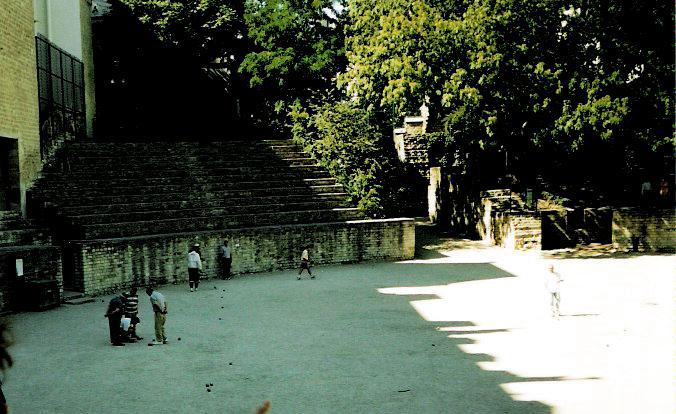 Jussieu, go up the rue Linné and turn right on a little street (Rue des Arènes). It's so bizarre you won't believe it. Dead calm hidden right in the middle of one of the city's busiest areas. People will be playing lawn games there, and some folks will likely be picnicking in the stands, which turns out to be a very fun thing to do (and there are a few boulangeries in the neighborhood that sell sandwiches in addition to the pastries you'd expect). They claim that over 10,000 people could fill this arena, which was built some time after the first or second century CE; it was only uncovered in modern times in the middle of the nineteenth century. Read the plaques if you can: apparently they used to fill the darned thing with water and do battle ship contests here, too. There's a whole website, by the way, dedicated to the playing of pétanque—lawn bowling, bocce, whatever you happen to call it—in the Arènes de Lutèce.
Jussieu, go up the rue Linné and turn right on a little street (Rue des Arènes). It's so bizarre you won't believe it. Dead calm hidden right in the middle of one of the city's busiest areas. People will be playing lawn games there, and some folks will likely be picnicking in the stands, which turns out to be a very fun thing to do (and there are a few boulangeries in the neighborhood that sell sandwiches in addition to the pastries you'd expect). They claim that over 10,000 people could fill this arena, which was built some time after the first or second century CE; it was only uncovered in modern times in the middle of the nineteenth century. Read the plaques if you can: apparently they used to fill the darned thing with water and do battle ship contests here, too. There's a whole website, by the way, dedicated to the playing of pétanque—lawn bowling, bocce, whatever you happen to call it—in the Arènes de Lutèce.
Nat reminds me that I really have to put something in here about the Catacombs, and he's right, of course (but don't tell him). Absolutely gazillions of bones (those of six million people) dating back hundreds of years, all there for you to enjoy several dozen meters under the streets of Paris. They're open odd times, so call before you go (01 43 22 47  63); as of this writing you can check the dead people out every day from 10:00 to 8:30 (although they stop letting people in at 7:30). The official entrance is at 1 av du Colonel Henri Rol-Tanguy, but it's really just right on the place Denfert-Rochereau (metro or RER of that name). It's 12 euros to get in. Wear cruddy shoes, because it can be pretty wet down there (you really are quite a ways down beneath the city), and you might get chilly even if it's really hot out. I'd wear old clothes, too, because if you brush up against, um, stuff, you can get crud on your clothes, and since you're not really sure what it is, better off not ruining your Chanel outfit (people were bandying about the phrase "corpse juice," but Tom's pretty sure that's not what any of this is). You'll likely want to use the flashlight app on your cell phone to see some of the details here (and to check out some of the darker recesss). If you spook easy, don't do this—you really have absolutely no idea how many bones there are, and once you're down there, you pretty much have to walk all the way through (a half mile maybe?). You desensitize to it, and then all of a sudden you turn a corner and you think, "Oh my god, how can there be that many bones here?" The really cool thing is that the galleries extend through all parts of the city, but you're more or less limited to being under the 14th arrondissement. As a word of warning, the catacombs have become very popular of late, so if the line extends around the two curves of the square, you're talking about a wait time of between 1.5 and 2 hours. Just so's you know. Tom thinks that some of you will be as fascinated as he is by this hugely detailed map of underground Paris, including catacombs and quarries.
63); as of this writing you can check the dead people out every day from 10:00 to 8:30 (although they stop letting people in at 7:30). The official entrance is at 1 av du Colonel Henri Rol-Tanguy, but it's really just right on the place Denfert-Rochereau (metro or RER of that name). It's 12 euros to get in. Wear cruddy shoes, because it can be pretty wet down there (you really are quite a ways down beneath the city), and you might get chilly even if it's really hot out. I'd wear old clothes, too, because if you brush up against, um, stuff, you can get crud on your clothes, and since you're not really sure what it is, better off not ruining your Chanel outfit (people were bandying about the phrase "corpse juice," but Tom's pretty sure that's not what any of this is). You'll likely want to use the flashlight app on your cell phone to see some of the details here (and to check out some of the darker recesss). If you spook easy, don't do this—you really have absolutely no idea how many bones there are, and once you're down there, you pretty much have to walk all the way through (a half mile maybe?). You desensitize to it, and then all of a sudden you turn a corner and you think, "Oh my god, how can there be that many bones here?" The really cool thing is that the galleries extend through all parts of the city, but you're more or less limited to being under the 14th arrondissement. As a word of warning, the catacombs have become very popular of late, so if the line extends around the two curves of the square, you're talking about a wait time of between 1.5 and 2 hours. Just so's you know. Tom thinks that some of you will be as fascinated as he is by this hugely detailed map of underground Paris, including catacombs and quarries.
Champs Elysées. I'd just avoid the whole thing, but if you want to take a stupid and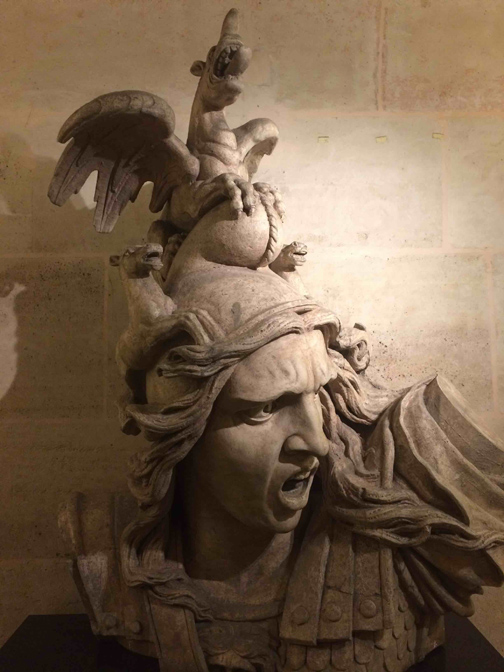 sickening walk, get off the metro at
sickening walk, get off the metro at 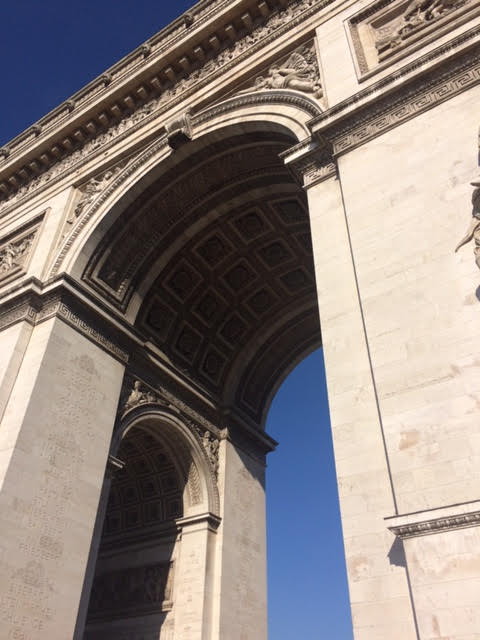 Charles de Gaulle Etoile and walk all the way down to the Place de la Concorde (which, by the way, leads into the Tuileries described above). Don't go to a café here because you'll have to mortgage your house to have a cup of coffee. Don't buy anything here for the same reason. Don't even go here. But while you're there, do go to the Arc de Triomphe. If you take the metro that I recommended above, you'll emrge up the escalator to a rather striking view of the monument, and just ahead of you, slightly on the left, you'll find the entrance to the underground passage that will take you safely to the arch. (Do not try to access the arch by crossing the incredibly busy traffic circle that surrounds it.) For a mere 12 euros you can climb—yes, climb, because there's no elevator—to the top of the arch and get a stunning view of the city. You can furthermore learn a lot about French history, you can view the tomb of the unknown soldier from World War I, and you can also see the astonishing sculptural reliefs on the sides of the arch (you're seeing the Marseillaise here).
Charles de Gaulle Etoile and walk all the way down to the Place de la Concorde (which, by the way, leads into the Tuileries described above). Don't go to a café here because you'll have to mortgage your house to have a cup of coffee. Don't buy anything here for the same reason. Don't even go here. But while you're there, do go to the Arc de Triomphe. If you take the metro that I recommended above, you'll emrge up the escalator to a rather striking view of the monument, and just ahead of you, slightly on the left, you'll find the entrance to the underground passage that will take you safely to the arch. (Do not try to access the arch by crossing the incredibly busy traffic circle that surrounds it.) For a mere 12 euros you can climb—yes, climb, because there's no elevator—to the top of the arch and get a stunning view of the city. You can furthermore learn a lot about French history, you can view the tomb of the unknown soldier from World War I, and you can also see the astonishing sculptural reliefs on the sides of the arch (you're seeing the Marseillaise here).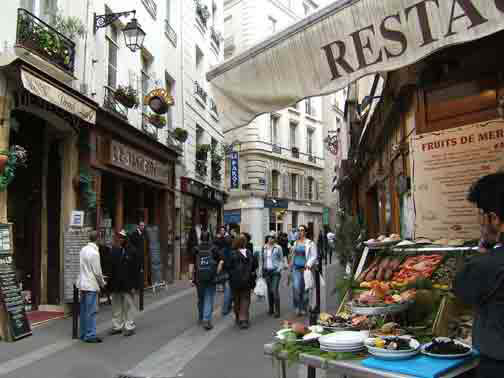
In the same general category, I suppose, are the little pedestrian streets between the boulevard Saint Michel and the rue Saint Jacques, including the rue de la Harpe, the rue Xavier Privas, the rue Saint-Séverin, and the rue du Chat Qui Pêche, the narrowest street in Paris (photo below). These streets date back to the Middle Ages, generally around the 12th century.
 Strikingly, the rue de la Huchette was known even then for its inns and meat roasters, and today you'll find those very entities still thriving. These streets are completely charming, of course, and they're jam-packed with people strolling around looking at the various restaurants, mostly Greek and other Mediterranean varieties. You'll have to learn to avoid the animateurs who stand out front and sometimes literally grab you by the arm to try to get you to come into their fine establishments (because most fine establishments usually need to get you to come in using force). These places are very cheap, and there's generally a reason why (see the Restaurant page for further information here). Tom doesn't really recommend that you eat here, unless it's to grab one of the sandwichs grecs and eat it on the run—these are actually quite excellent, especially with frites. But you will enjoy walking around this area, even if you're not sure why.
Strikingly, the rue de la Huchette was known even then for its inns and meat roasters, and today you'll find those very entities still thriving. These streets are completely charming, of course, and they're jam-packed with people strolling around looking at the various restaurants, mostly Greek and other Mediterranean varieties. You'll have to learn to avoid the animateurs who stand out front and sometimes literally grab you by the arm to try to get you to come into their fine establishments (because most fine establishments usually need to get you to come in using force). These places are very cheap, and there's generally a reason why (see the Restaurant page for further information here). Tom doesn't really recommend that you eat here, unless it's to grab one of the sandwichs grecs and eat it on the run—these are actually quite excellent, especially with frites. But you will enjoy walking around this area, even if you're not sure why.
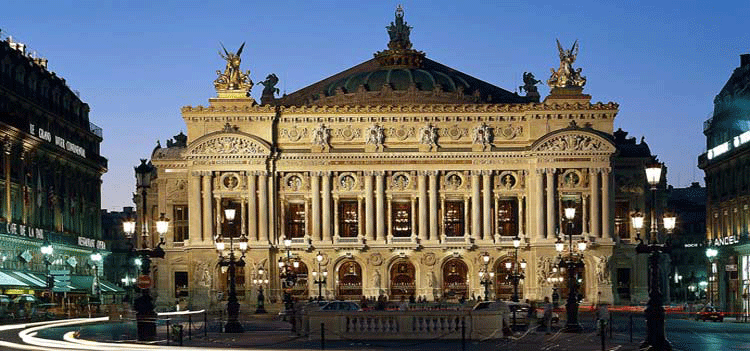 The Opera, at the métro stop and place of the same name, is a wildly ornate nineteenth-century structure engineered by Garnier. You can visit it for 15 euros, or you can have an after-hours guided tour, the price of which seems to be mysterious and secret. Tom's not completely sure what's included in the self-tour, because they seem to change that all the time. He does remember that at one point when he was on one of those he wandered through an open door and wound up in a luxury box near the stage. Then he got yelled at. Go in and sit in one of the plush seats. You'll get yelled at, too, and chased out, but it's worth it. The place is so wonderfully excessive that wherever you look there's something extraordinary, and that means the ceiling, too. There's a sort of underground lake underneath the structure, and the story goes that a guy who was burned in a fire lived in the Opéra and freaked people out. Ridiculous.
The Opera, at the métro stop and place of the same name, is a wildly ornate nineteenth-century structure engineered by Garnier. You can visit it for 15 euros, or you can have an after-hours guided tour, the price of which seems to be mysterious and secret. Tom's not completely sure what's included in the self-tour, because they seem to change that all the time. He does remember that at one point when he was on one of those he wandered through an open door and wound up in a luxury box near the stage. Then he got yelled at. Go in and sit in one of the plush seats. You'll get yelled at, too, and chased out, but it's worth it. The place is so wonderfully excessive that wherever you look there's something extraordinary, and that means the ceiling, too. There's a sort of underground lake underneath the structure, and the story goes that a guy who was burned in a fire lived in the Opéra and freaked people out. Ridiculous.
Moulin Rouge. 82 boulevard de Clichy, métro Blanche (01 53 09 82 82). You've seen the movie with Nicole Kidman. Well, this is nothing like that. Which is not to say that you shouldn't 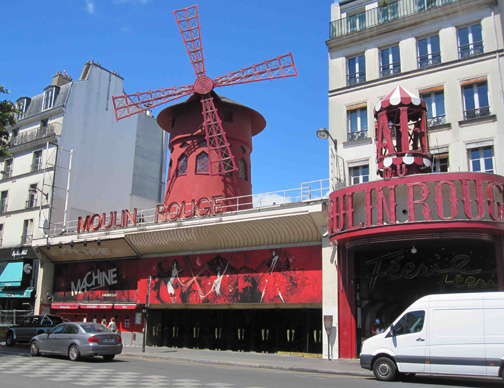 go—only that you shouldn't go expecting, well, that. What you've got here is basically a Las Vegas style show, only it's French. I went once—a friend of a friend was a dancer there, and she got us front-row seats—and I thoroughly enjoyed it, but you'd better bring a sense of irony if you go. The thing is, the dancers are truly amazing, and they make what they're doing look effortless. In the famous can-can, they're actually kicking back up and over their shoulders. If you're sitting close you can see the strain on their smiling faces. The horses are good, the dogs, everything is good. But it's so weird and excessive that you can't quite believe it. The word "spectacle" must have been coined for the Moulin Rouge. If you do decide to go, consider not doing the dinner show, but one of the later ones, where you get a bottle of champagne. You might need it. Thing about the Moulin Rouge, though, is its history: the place has been there since 1889, and so much has happened there that it's worth checking out even if you decide not to go in.
go—only that you shouldn't go expecting, well, that. What you've got here is basically a Las Vegas style show, only it's French. I went once—a friend of a friend was a dancer there, and she got us front-row seats—and I thoroughly enjoyed it, but you'd better bring a sense of irony if you go. The thing is, the dancers are truly amazing, and they make what they're doing look effortless. In the famous can-can, they're actually kicking back up and over their shoulders. If you're sitting close you can see the strain on their smiling faces. The horses are good, the dogs, everything is good. But it's so weird and excessive that you can't quite believe it. The word "spectacle" must have been coined for the Moulin Rouge. If you do decide to go, consider not doing the dinner show, but one of the later ones, where you get a bottle of champagne. You might need it. Thing about the Moulin Rouge, though, is its history: the place has been there since 1889, and so much has happened there that it's worth checking out even if you decide not to go in.
 Pigalle Sex shows, shops, etc. First off, this neighborhood, which was so famous for being naughty up until about a couple decades ago, has changed enormously. The sex shops are still there, but there are far fewer of them and they look, paradoxically enough, both more and less sordid than they did back in the old days. There are still places that advertise lap dances, but you don't see the big "life shows" that they used to have (basically strip shows). The area used to have giant, neon-facaded structures advertising fantasies and fetishes with giant, lurid photos, but it's much tamer now. (The Rendez Vous des Artistes was apparently where everybody went for a drink after their night shift was done.) If you want to see some of what's left, Take a walk down the boulevard Clichy toward the west, from Pigalle to Blanche and you'll see what's left. Many fewer prostitutes as well. It's not exactly anybody's kindergarten today, but it got a facelift much like the one Disney (or whoever) gave to Times Square a while back. Now it's got some very popular restaurants and cafés on it, including the very popular Bouillon Pigalle, which has received rave reviews from some pretty conservative and demanding publications.
Pigalle Sex shows, shops, etc. First off, this neighborhood, which was so famous for being naughty up until about a couple decades ago, has changed enormously. The sex shops are still there, but there are far fewer of them and they look, paradoxically enough, both more and less sordid than they did back in the old days. There are still places that advertise lap dances, but you don't see the big "life shows" that they used to have (basically strip shows). The area used to have giant, neon-facaded structures advertising fantasies and fetishes with giant, lurid photos, but it's much tamer now. (The Rendez Vous des Artistes was apparently where everybody went for a drink after their night shift was done.) If you want to see some of what's left, Take a walk down the boulevard Clichy toward the west, from Pigalle to Blanche and you'll see what's left. Many fewer prostitutes as well. It's not exactly anybody's kindergarten today, but it got a facelift much like the one Disney (or whoever) gave to Times Square a while back. Now it's got some very popular restaurants and cafés on it, including the very popular Bouillon Pigalle, which has received rave reviews from some pretty conservative and demanding publications.
Readers Chime In...
Lee writes: "I recall going to the Lido (116 bis Avenue des Champs-Élysées, 8th, métro Georges V, 01 89 97 09 55) to see the show. I had read, perhaps in one of Arthur Frommer's books, that if you request a ticket for the "Promenoir" or the bar, you can get to see the show for less money. Promenoir may have been at the Folies Bergère (32 rue Richer, 9th, métro Cadet, 08 00 00 16 50) where you eventually can get a seat once the show starts; or the bar at the Lido. Anyhow, if you avoid the dinner shows and take advantage of the bar or standing in the rear of the theater, you can do well. In each place, the show was great."
Steven has this recreational tip: if you like motorcycles, cars, boats, and other hobby items, the Avenue of the Grande Armée is the place to be. Go between the Arc de Triomphe and the Seine River to the northwest and you will find dozens of places that appeal to these interests.
Ryan writes, "It's especially neat to see Paris by Segway by night. My mom and grandma and I rented Segways. My grandma was 73 at the time and their oldest rider thus far. It was awesome. Segways are fun. You can ride all over the sidewalks and all sorts of people came up and asked for brochures. We stopped at an ice cream place and recharged." Tom will add that he's listened to some of the tour guides' descriptions of Paris, and let's just say that, well, they're no Tom.
César recommends a trip to the top of the Tour Montparnasse (metro Montparnasse-Bienvenue): "You can climb up to the last floor of the tower by a high-speed elevator. There you will have 360-degree view of Paris with maps to help you locate the main tourist attractions. There is also a café to enjoy the view while drinking something and you can climb up by stairs to the very top of the building. Bring a coat because it is very windy there. The price for students is 16 euros; 21 for adults. It's, of course, nicer in summer daylight. You will get amazing pictures form there."
Anne L. of Rochester, NY, recommends the view from the Pompidou Center: "The view from the outside escalator going all the way to the top of the Pompidou museum is quite wonderful. When you get there the restaurant on the top floor of the museum is chic and modern; the service is good and the food quite tasty if rather expensive."
Isn't it time you submitted that thing to do in Paris that you've been thinking about? Do it now, and do it here.

 As you're walking around, you'll no doubt get hungry, and you'll be tempted to bop into one of the many, many pâtisseries (bakeries) that you see all over Paris. Do it. You'll quickly learn that most of the stuff is even better than it looks. Tom's absolute favorite thing in this domain is the pain au chocolat, which is often described as a chocolate croissant by people who are idiots. A pain au chocolat is, rather, a pastry that consists of more or less the same pâte feuilletée (although ever so slightly sweetened) you find in a croissant, and it's got a few morsels of real, good, bittersweet chocolate in it. It's not sickeningly sweet, because there isn't that much chocolate in it—there's just exactly enough. I'm still trying to find the best one in the world, so we're taking nominations
As you're walking around, you'll no doubt get hungry, and you'll be tempted to bop into one of the many, many pâtisseries (bakeries) that you see all over Paris. Do it. You'll quickly learn that most of the stuff is even better than it looks. Tom's absolute favorite thing in this domain is the pain au chocolat, which is often described as a chocolate croissant by people who are idiots. A pain au chocolat is, rather, a pastry that consists of more or less the same pâte feuilletée (although ever so slightly sweetened) you find in a croissant, and it's got a few morsels of real, good, bittersweet chocolate in it. It's not sickeningly sweet, because there isn't that much chocolate in it—there's just exactly enough. I'm still trying to find the best one in the world, so we're taking nominations